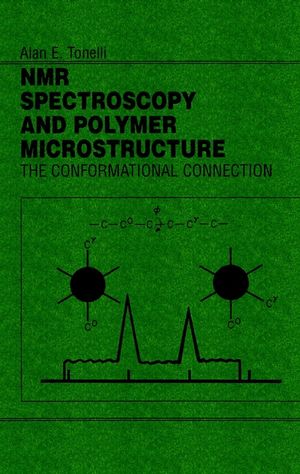NMR Spectroscopy and Polymer Microstructure: The Conformational ConnectionISBN: 978-0-471-18748-6
Hardcover
264 pages
September 1989
 This is a Print-on-Demand title. It will be printed specifically to fill your order. Please allow an additional 10-15 days delivery time. The book is not returnable.
|
||||||
Preface
1. The Microstructure of Polymer Chains
1.1 Introduction
1.2 Polymers Are Macromolecules
1.3 Polymer Microstructures from Polymerization of Monomers
1.3.1 Directional Isomerism
1.3.2 Stereochemical Isomerism
1.3.3 Geometrical Isomerism
1.3.4 Truly Asymmetric Polymers
1.3.5 Copolymer Sequences
1.4 Organization of Polymer Chains
1.5 Polymer Properties and Their Relation to Microstructure
2. Nuclear Magnetic Resonance
2.1 Introduction
2.2 The NMR Phenomenon
2.2.1 Resonance
2.2.2 Interactions and Relaxations of Nuclear Spins
2.2.3 Chemical Shift
2.2.4 Spin-Spin Coupling
2.3 Experimental Observation of NMR
3. High-Resolution NMR of Polymers
3.1 Introduction
3.2 ¯1H NMR
3.3 ¯13C NMR
3.4 High-Resolution ¯13C NMR in the Solid State
3.4.1 Dipolar Broadening
3.4.2 Chemical-Shift Anisotropy
3.4.3 Cross-Polarization
3.5 Two-Dimensional NMR
3.6 Other Nuclei-¯15N, ¯19F, ¯29Si, and ¯31p
4. ¯13C NMR of Polymers
4.1 Introduction
4.2 ¯13C Chemical Shifts and Their Dependence on Microstructure
4.2.1 ¯13C Nuclear Shielding
4.2.2 Substituent Effects on ¯13C Chemical Shifts
4.2.3 The -Substituent Effect in ¯13C NMR
4.2.4 -gauche Effects in ¯13C NMR
5. -gauche Effect Method of Predicting ¯13C NMR Chemical Shifts
5.1 Introduction
5.2 Polymer Conformations
5.2.1 Rotational Isomeric-State Model of Polymers
5.2.2 Average Bond Conformations
5.3 -gauche Effect Calculation of ¯13C NMR Chemical Shifts
5.3.1 Small-Molecule Example
5.3.2 Macromolecular Example
6. Determination of Stereosequences in Vinyl Polymers
6.1 Introduction
6.2 Traditional Methods
6.2.1 Stereoregular Polymers
6.2.2 Epimerization of Stereoregular Polymers
6.2.3 Model Compounds
6.2.4 Assumed Polymerization Mechanism
6.3 2D NMR Determination of Vinyl Polymer Stereosequence
6.4 Application of -gauche Effect Method
6.5 Establishing Vinyl Polymerization Mechanisms from Stereosequence Analysis
7. Microstructural Defects in Polymers
7.1 Introduction
7.2 Determining the Regiosequence of PVF_2
7.2.1 ¯13C NMR
7.2.2 ¯19F NMR
7.2.3 2D ¯19F NMR
7.3 Regiosequence Defects in PPO
8. Copolymer Microstructure
8.1 Introduction
8.2 Comonomer Sequences
8.3 Copolymer Stereosequences
8.4 Copolymer Conformations
8.5 Copolymerization Mechanisms
9. Chemically Modified Polymers
9.1 Introduction
9.2 Transformation of PVC to Ethylene-Vinyl Chloride Copolymers
9.2.1 Tri-n-butyltin Hydride Reduction of PVC
9.2.2 Microstructures of E-V Copolymers
9.2.3 (n-Bu)_3SnH Reduction of PVC Model Compounds
9.2.4 Computer Simulation of TCH and PVC Reduction
9.3 Modification of 1,4-Poly(butadienes) with Dihalocarbenes
9.3.1 Possible Microstructures in the Dihalocarbene Adducts of PBD
9.3.2 NMR of Dihalocarbene Adducts of PBD
10. Biopolymers
10.1 Introduction
10.2 Polypeptides
10.2.1 2D NMR Assignment of ¯1H Resonances
10.2.2 Determination of Polypeptide Conformation by 2D NMR
10.3 Polynucleotides
10.4 Polysaccharides
11. Solid Polymers
11.1 Introduction
11.2 Solid-State Polymer Conformation
11.3 Interchain Packing in Solid Polymers
11.4 Molecular Motion in Solid Polymers
11.5 Application of CPMAS/DD ¯13C NMR to Solid Polymers
11.5.1 Morphology and Motion in Polymer Crystals
11.5.2 Solid-Solid Polymer Phase Transitions
11.6 Other Nuclei Observed In Solid-State Polymer Spectra
11.6.1 CPMAS/DD ¯29Si NMR
11.6.2 MAS/DD ¯31p NMR
11.6.3 CPMAS/DD ¯15N NMR
11.7 Concluding Remarks
1. The Microstructure of Polymer Chains
1.1 Introduction
1.2 Polymers Are Macromolecules
1.3 Polymer Microstructures from Polymerization of Monomers
1.3.1 Directional Isomerism
1.3.2 Stereochemical Isomerism
1.3.3 Geometrical Isomerism
1.3.4 Truly Asymmetric Polymers
1.3.5 Copolymer Sequences
1.4 Organization of Polymer Chains
1.5 Polymer Properties and Their Relation to Microstructure
2. Nuclear Magnetic Resonance
2.1 Introduction
2.2 The NMR Phenomenon
2.2.1 Resonance
2.2.2 Interactions and Relaxations of Nuclear Spins
2.2.3 Chemical Shift
2.2.4 Spin-Spin Coupling
2.3 Experimental Observation of NMR
3. High-Resolution NMR of Polymers
3.1 Introduction
3.2 ¯1H NMR
3.3 ¯13C NMR
3.4 High-Resolution ¯13C NMR in the Solid State
3.4.1 Dipolar Broadening
3.4.2 Chemical-Shift Anisotropy
3.4.3 Cross-Polarization
3.5 Two-Dimensional NMR
3.6 Other Nuclei-¯15N, ¯19F, ¯29Si, and ¯31p
4. ¯13C NMR of Polymers
4.1 Introduction
4.2 ¯13C Chemical Shifts and Their Dependence on Microstructure
4.2.1 ¯13C Nuclear Shielding
4.2.2 Substituent Effects on ¯13C Chemical Shifts
4.2.3 The -Substituent Effect in ¯13C NMR
4.2.4 -gauche Effects in ¯13C NMR
5. -gauche Effect Method of Predicting ¯13C NMR Chemical Shifts
5.1 Introduction
5.2 Polymer Conformations
5.2.1 Rotational Isomeric-State Model of Polymers
5.2.2 Average Bond Conformations
5.3 -gauche Effect Calculation of ¯13C NMR Chemical Shifts
5.3.1 Small-Molecule Example
5.3.2 Macromolecular Example
6. Determination of Stereosequences in Vinyl Polymers
6.1 Introduction
6.2 Traditional Methods
6.2.1 Stereoregular Polymers
6.2.2 Epimerization of Stereoregular Polymers
6.2.3 Model Compounds
6.2.4 Assumed Polymerization Mechanism
6.3 2D NMR Determination of Vinyl Polymer Stereosequence
6.4 Application of -gauche Effect Method
6.5 Establishing Vinyl Polymerization Mechanisms from Stereosequence Analysis
7. Microstructural Defects in Polymers
7.1 Introduction
7.2 Determining the Regiosequence of PVF_2
7.2.1 ¯13C NMR
7.2.2 ¯19F NMR
7.2.3 2D ¯19F NMR
7.3 Regiosequence Defects in PPO
8. Copolymer Microstructure
8.1 Introduction
8.2 Comonomer Sequences
8.3 Copolymer Stereosequences
8.4 Copolymer Conformations
8.5 Copolymerization Mechanisms
9. Chemically Modified Polymers
9.1 Introduction
9.2 Transformation of PVC to Ethylene-Vinyl Chloride Copolymers
9.2.1 Tri-n-butyltin Hydride Reduction of PVC
9.2.2 Microstructures of E-V Copolymers
9.2.3 (n-Bu)_3SnH Reduction of PVC Model Compounds
9.2.4 Computer Simulation of TCH and PVC Reduction
9.3 Modification of 1,4-Poly(butadienes) with Dihalocarbenes
9.3.1 Possible Microstructures in the Dihalocarbene Adducts of PBD
9.3.2 NMR of Dihalocarbene Adducts of PBD
10. Biopolymers
10.1 Introduction
10.2 Polypeptides
10.2.1 2D NMR Assignment of ¯1H Resonances
10.2.2 Determination of Polypeptide Conformation by 2D NMR
10.3 Polynucleotides
10.4 Polysaccharides
11. Solid Polymers
11.1 Introduction
11.2 Solid-State Polymer Conformation
11.3 Interchain Packing in Solid Polymers
11.4 Molecular Motion in Solid Polymers
11.5 Application of CPMAS/DD ¯13C NMR to Solid Polymers
11.5.1 Morphology and Motion in Polymer Crystals
11.5.2 Solid-Solid Polymer Phase Transitions
11.6 Other Nuclei Observed In Solid-State Polymer Spectra
11.6.1 CPMAS/DD ¯29Si NMR
11.6.2 MAS/DD ¯31p NMR
11.6.3 CPMAS/DD ¯15N NMR
11.7 Concluding Remarks



